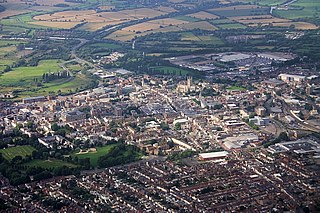
Gloucester is a cathedral city and the county town of Gloucestershire in the South West of England. Gloucester lies on the River Severn, between the Cotswolds to the east and the Forest of Dean to the west, 19 miles (31 km) east of Monmouth, and 17 miles (27 km) east of the border with Wales. Including suburban areas, Gloucester has a population of around 150,000. It is a port, linked via the Gloucester and Sharpness Canal to the Severn Estuary.

Stroud is a market town and civil parish in the centre of Gloucestershire, England. It is the main town in Stroud District.

Barnwood House Hospital was a private mental hospital in Barnwood, Gloucester, England. It was founded by the Gloucester Asylum Trust in 1860 as Barnwood House Institution and later became known as Barnwood House Hospital. The hospital catered for well-to-do patients, with reduced terms for those in financial difficulties. It was popular with the military and clergy, and once counted an Archbishop amongst its patients. During the late nineteenth century Barnwood House flourished under superintendent Frederick Needham, making a healthy profit and receiving praise from the Commissioners in Lunacy. Even the sewerage system was held up as a model of good asylum practice. After the First World War service patients, including war poet and composer Ivor Gurney, were treated with a regime of psychotherapy and recreations such as cricket.
Samuel Whitfield Daukes (1811–1880) was an English architect, based in Gloucester and London.

Gloucestershire College is a college of further and higher education in the county of Gloucestershire, United Kingdom.
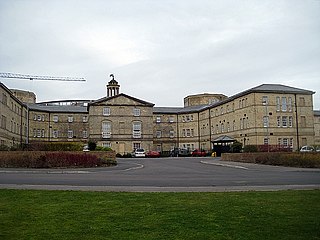
The Stanley Royd Hospital, earlier named the West Riding Pauper Lunatic Asylum, was a mental health facility in Wakefield, West Yorkshire. It was managed by the Wakefield and Pontefract Community Health NHS Trust.
Healthcare in the city of Bristol, England and the surrounding area is largely provided by the National Health Service (NHS), through the Bristol, North Somerset and South Gloucestershire clinical commissioning group. Facilities include a large teaching hospital – Bristol Royal Infirmary – which offers nationally commissioned specialist cardiac, cancer and children's services from its city-centre campus to patients in the southwest of England and beyond.

John Giles was a British architect. He was born in Lincoln, probably in 1830, and his family came from Branston near Lincoln. He was articled to the Lincoln architect Pearson Bellamy. He had moved to London by 1859 and with Pearson Bellamy entered a number competitions for major public buildings. Of these only one, for Grimsby Town, was successful. In London he was responsible for a number of major projects including the Langham Hotel. He also started in 1869 on the design of hospitals with the Infirmary to Hampstead Union Workhouse. After a short period of partnership with Lewis Angel, when Stratford Town Hall was built and with Edward Biven, by 1873 he was in partnership with Albert Edward Gough. They were joined in the practice by J E Trollope and they became involved in the design of Arts and Crafts housing in London's west end. Giles had business interests in the City of London and was noted in 1867 as being a Director of the Imperial Guardian Life Insurance Company.

Rainhill Hospital was a very large psychiatric hospital complex that was located in Rainhill, formerly Lancashire but now Merseyside, England.
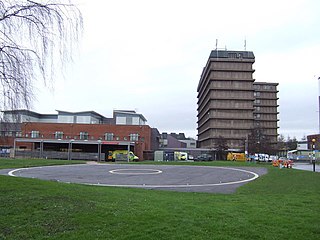
Gloucestershire Royal Hospital is an acute District General Hospital on the Great Western Road in Gloucester operated by the Gloucestershire Hospitals NHS Foundation Trust.

Thomas Fulljames FRIBA was an architect active in Gloucestershire, England, in the first half of the nineteenth century. As diocesan surveyor from 1832 until 1870, latterly in partnership with Frederick Sandham Waller, he designed, reconstructed or extended a number of churches in Gloucestershire.
The Horton Road Stadium was a football and greyhound racing stadium situated in Gloucester, England.

The Gloucestershire Royal Infirmary was a hospital in Southgate Street, Gloucester.
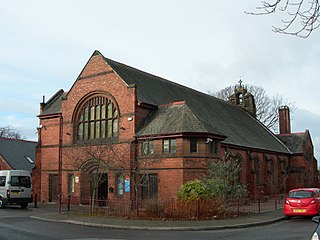
Winwick Hospital was a mental health facility at Winwick, Cheshire, England.

Coney Hill Hospital was a mental health facility in Gloucester, England.

Littlemore Hospital was a mental health facility on Sandford Road in Littlemore, Oxfordshire.

Mapperley Hospital is a mental health facility on Porchester Road in Nottingham, England.

St Francis Hospital was a mental health facility in Haywards Heath, West Sussex, England. The main building survives and is a Grade II listed building.

The Royal Dundee Liff Hospital, previously known as Dundee Lunatic Asylum and Dundee Royal Lunatic Asylum, was a mental health facility originally established in 1812 in Dundee, Scotland. It was originally located in premises in Albert Street Dundee, but later moved out of the town to new buildings in the nearby parish of Liff and Benvie. Buildings at Liff included Greystanes House, which was the main building, and, Gowrie House, which was the private patients' facility. Both Grade B listed buildings.
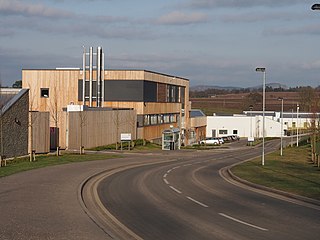
The Murray Royal Hospital is a mental health facility in Perth, Scotland. It is managed by NHS Tayside. The original main building is a Category A listed building.



















